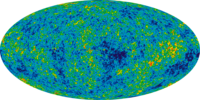
Photo from wikipedia
In the standard model the (Brout-Englert-)Higgs quartic coupling becomes negative at high energies rendering our current electroweak vacuum metastable, but with an instability timescale much longer than the age of… Click to show full abstract
In the standard model the (Brout-Englert-)Higgs quartic coupling becomes negative at high energies rendering our current electroweak vacuum metastable, but with an instability timescale much longer than the age of the Current Universe. During cosmological Inflation, unless there is a non-minimal coupling to gravity, the Higgs field is pushed away from the origin of its potential due to quantum fluctuations. It is therefore a mystery how we have remained in our current vacuum if we went through such a period of Inflation. In this work we study the effect of top quarks created gravitationally during Inflation and their effect upon the Higgs potential using only General Relativity with minimal couplings and Standard Model particle physics. We show how the evolution of the Higgs field during Inflation is modified coming to the conclusion that this effect is non negligible for scales of Inflation close to or larger than the stability scale but small for scales where the Higgs is stable. Also, we briefly discuss the effect of other fermions to the Higgs instability.
Journal Title: Physical Review D
Year Published: 2019
Link to full text (if available)
Share on Social Media: Sign Up to like & get
recommendations!